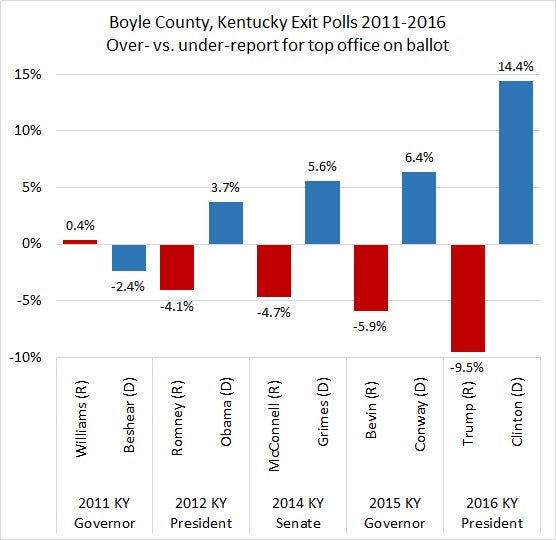Several months have passed since the 2016 election. Pundits and political scientists alike continue to examine why the polls, especially state-level polls, underestimated Donald Trump’s level of support in the days and weeks leading up Election Day.
One prominent theory argues that the prevalence of “shy Trump voters” explains the difference: many Republicans were simply reluctant to admit to telephone pollsters that they were planning to vote for a controversial candidate like Trump. While some analysts have found evidence in favor of this theory, others have not.
Another theory is that of “non-response bias”: Trump voters were simply less likely to be included in the survey samples, either because pollsters didn’t reach them or because those voters declined to participate.
I run an exit polling survey project in Boyle County, Kentucky as part of a regular community-based learning component of our political science courses at Centre College. Our students have surveyed over 1,000 randomly-selected voters on their way out of the voting booths in every fall election since 2011.
To examine these competing theories, I compared the results of the exit polls with the actual results in Boyle County in each of these recent elections. Central Kentucky is an especially appropriate place to test for such an effect given that the economic and demographic characteristics are favorable to a candidate like Mr. Trump (he won Boyle County with 62 percent of the vote). The results are shown here:

Each bar in the graph shows the difference between our exit polling results and the actual results in Boyle County, Kentucky for the top office on the ballot. For example, in the 2011 Kentucky gubernatorial election our exit poll showed Republican David Williams winning 29.5 percent of the vote among Boyle County voters. In reality, he won 29.1 percent, meaning that our exit poll overestimated his level of support by 0.4 percent. In contrast, our exit poll underestimated Democrat Steve Beshear’s support in Boyle County by 2.4 percent.
The results shown in the graph demonstrate a clear trend. While our exit poll was almost spot-on in the 2011 election, it showed Republicans doing increasingly poor in our exit poll compared to actual results and Democrats doing increasingly better over five years of elections. In 2016, our exit poll showed Donald Trump winning 52.6 percent of Boyle County voters (he actually won 62.1 percent) and Hillary Clinton winning 47.4 percent (she actually won 33 percent).
It is possible that this trend is due to the “shy Trump voter” theory. Perhaps Republicans became increasingly reluctant to report who they voted for. We are skeptical of this explanation, though. Why would they hide voting for the Republican candidate in other recent high-profile elections and why would this trend be consistently growing over the last several years if it was simply a matter of Trump? Also, our exit poll respondents fill out a paper survey in privacy and so are free to candidly report who they voted for.
A more likely explanation is that Republican voters in Boyle County, Kentucky, especially the kind inclined to support Donald Trump’s brand of anti-elite populism, became increasingly unwilling to participate in the exit poll surveys on Election Day over the last several years. After all, anti-establishment politics have become increasingly popular lately.
It is also becoming increasingly common for conservative commentators to accuse professional pollsters of being in cahoots with the “elite media” and the political establishment. In our case, the growth in anti-elite sentiment in recent years could also extend in a rural Kentucky county to an exit poll project run by a private liberal arts college. It is reasonable to infer that this same effect could have been present in many swing states in 2016, especially those with high numbers of working class voters in rural counties like Wisconsin, Pennsylvania, and Michigan.
As the polling industry has increasingly come to be perceived as part of the “elite establishment” by many populist conservatives, a growing proportion of the Republican electorate may simply be refusing to participate in public opinion polls. This, in turn, leads to their voting preferences being underestimated in public opinion surveys. Thus, many of the state-level polls were wrong in 2016 simply because many Trump voters told pollsters to take a hike.
This may also help explain conservative and populist victories in many recent elections where polls predicted a loss. These include Brexit, the 2015 Kentucky gubernatorial election, and the 2015 UK parliament election.
If the polling industry continues to be perceived by many conservatives as part of the “elite establishment,” we should expect that public opinion polls will persist in underestimating conservative populist sentiment in high-profile elections.
